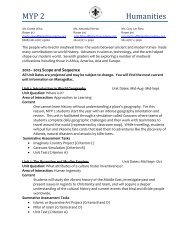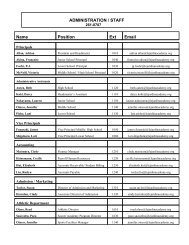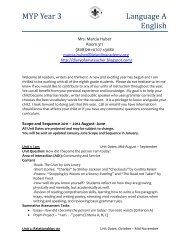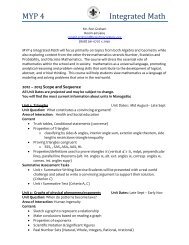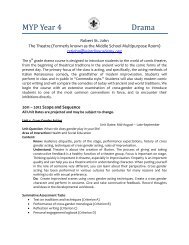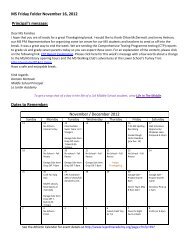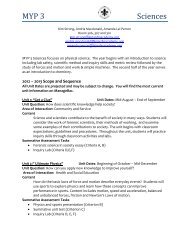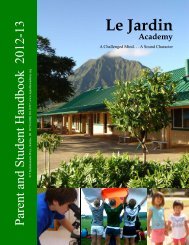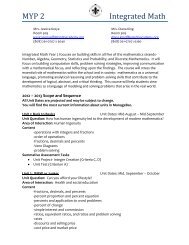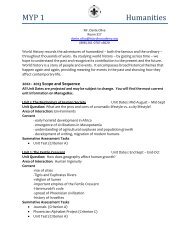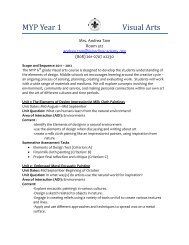MYP Year 5 Drama - Le Jardin Academy
MYP Year 5 Drama - Le Jardin Academy
MYP Year 5 Drama - Le Jardin Academy
Create successful ePaper yourself
Turn your PDF publications into a flip-book with our unique Google optimized e-Paper software.
<strong>MYP</strong> <strong>Year</strong> 5<br />
<strong>Drama</strong><br />
Robert St. John<br />
The Theatre (formerly known as the Middle School Multipurpose Room)<br />
rstjohn@lejardinacademy.org<br />
The 10th grade drama course is designed to introduce students to the world of Realism in theatre,<br />
from the beginning of realistic traditions in the Nineteenth Century to the realistic acting styles of the<br />
present day. The primary focus of the class is the script, and students are required to read from<br />
classic texts of Realistic theatre and will perform scenes in class, both script based and improvised in<br />
realistic acting style. They will also analyze film performances by great actors. Students will also<br />
study modern realistic script writing and have an opportunity to enter a play writing contest and<br />
possibly have their work produced.<br />
2011 – 2012 Scope and Sequence<br />
All Unit Dates are projected and may be subject to change.<br />
Unit 1: An Introduction to Realism<br />
Unit Dates: Mid-August – Late-September<br />
Unit Question: Why simulate reality?<br />
Area of Interaction: Health and Social Education<br />
Content:<br />
Know: The history of realism in theatre and the importance of Anton Chekhov and Henrik<br />
Ibsen. The play “The Doll’s House” and its importance as an example of Realistic Theatre.<br />
Understand: Realism is an artistic movement that began in the 1800s in Europe and was<br />
taken up by American actors in the 20 th Century. It has greatly influenced American movie<br />
making. It replaced representational acting. It is very recognizable. Artists simulate reality to<br />
allow us to look and ourselves and learn.<br />
Do: Research and create a presentation on an aspect of the history of Realism. Take a test on<br />
the history of Realism. Perform realistic improvisation with a partner. Give and take<br />
feedback. Create a realistic scene with memorized lines and a developed character. Write a<br />
reflection about the process.<br />
Summative Assessment Tasks<br />
• Test (Criterion A)<br />
• Performance of original scene with a partner (Criterion B)<br />
• Reflection writing (Criterion C)<br />
• Personal engagement (Criterion D)<br />
Unit 2: Dialogue in a Realistic Play<br />
Unit Dates: Late-September–Mid-October<br />
Unit Question: Why do we analyze the details of a system?<br />
Area of Interaction: Approaches to <strong>Le</strong>arning<br />
Content:
Know: The characteristics of realistic dialogue. How to recognize believable characters and<br />
realistic lines and how to create them. How to read and write subtext. How to act from a<br />
script.<br />
Understand: Realistic dialogue contains a lot of subtext because that is the way people<br />
speak. Realistic theatre uses a lot of props and stage business it best simulates reality. We<br />
analyze the way things work because it allows us to accurately duplicate it.<br />
Do: Perform from a script with heavy subtext and communicate meaning. Write a reflection<br />
about the process. Take a test about the characteristics of realistic dialogue.<br />
Summative Assessment Tasks<br />
• Test (Criterion A)<br />
• Performance (Criterion B)<br />
• Reflection writing (Criterion C)<br />
• Personal engagement (Criterion D)<br />
Unit 3: Studying and Staging Scenes from Classic Realistic Plays<br />
Unit Dates: Mid-October-December<br />
Unit Question: What can we learn from masterworks?<br />
Area of Interaction: Approaches to <strong>Le</strong>arning<br />
Content:<br />
Know: The plays “Long Day’s Journey Into Night” by Eugene O’Neill, “Whose Afraid of<br />
Virginia Woolf?” by Edward Albee, “A Streetcar Named Desire” by Tennessee Williams, and<br />
“Death of a Salesman” by Arthur Miller.<br />
Understand: These four plays are important as examples of realism in 20 th Century American<br />
theatre. Master artists affect artists for generations and subsequent artists build on each<br />
other’s work. An actor prepares for a part by studying the lines, by researching and by<br />
reflecting on a character’s motivation.<br />
Do: Write a scene in the style of one of these four playwrights. Perform scenes from these<br />
four plays. Write a reflection about the process.<br />
Summative Assessment Tasks<br />
• Test (Criterion A)<br />
• Performance (Criterion B)<br />
• Reflection writing (Criterion C)<br />
• Personal engagement (Criterion D)<br />
Unit 4: Deadly Dialogue and Complex Characters: Advanced Play Writing<br />
Unit Dates: Early-January–Late-March<br />
Unit Question: What makes people tick?<br />
Area of Interaction: Health and Social Education<br />
Content:<br />
Know: Script formatting. How to create believable dialogue. How to create characters with<br />
depth. How to be true to what you create. How to incorporate theatricality into your play<br />
script.<br />
Understand: By creating character-based plays, the playwright relinquishes control and<br />
allows the characters to become more realistic rather than forcing them into a plot. People’s<br />
actions and words reflect their motivations.<br />
Do: Write an original script following the teacher’s process closely. Give and take feedback.<br />
Take a test on playwriting principles. Write a reflection about the process.
Summative Assessment Tasks<br />
• Test—Playwriting Principles (Criterion A)<br />
• Written Script (Criterion B)<br />
• Reflection writing (Criterion C)<br />
• Personal engagement (Criterion D)<br />
Unit 5: Lighting the Match: The Scene Production Process Using “The Kentucky Cycle”<br />
Unit Dates: Early-April—Late-May<br />
Unit Question: How can our mistakes alter the future?<br />
Area of Interaction: Environments<br />
Content:<br />
Know: The play “The Kentucky Cycle.” How to develop a character and prepare for a<br />
performance. How to stage a scene from a play. How to act from a script.<br />
Understand: An actor must create the feeling of an environment and how that environment<br />
is projected through the character. Actors have to cooperate through the rehearsal process.<br />
We can alter the world for better or worse through our actions.<br />
Do: Perform from “The Kentucky Cycle” as the class reads through the entire play. Choose a<br />
scene from the play with a partner or partners and perform the scene with props and<br />
costumes and memorized lines. Communicate the character’s motivations with well<br />
delivered lines. Take a test on play production problems.<br />
Summative Assessment Tasks<br />
• Test—Understanding Production Problems (Criterion A)<br />
• Performance of Costumed Scene (Criterion B)<br />
• Reflection writing (Criterion C)<br />
• Personal engagement (Criterion D)<br />
Office hours in the Theatre:<br />
Students are encouraged to use office hours to receive extra learning support. These office hours<br />
may be changed due to scheduled faculty meetings, conferences, or unforeseen circumstances.<br />
12:30-1:30 pm “J” “R” and “I” days.<br />
3:00-3:30 every day.





